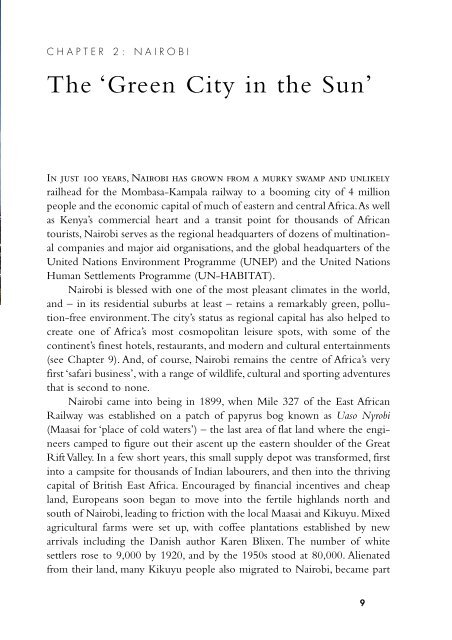KARIBU KENYA - UNON - the United Nations Office at Nairobi
KARIBU KENYA - UNON - the United Nations Office at Nairobi
KARIBU KENYA - UNON - the United Nations Office at Nairobi
You also want an ePaper? Increase the reach of your titles
YUMPU automatically turns print PDFs into web optimized ePapers that Google loves.
CHAPTER 2: NAIROBI<br />
The ‘Green City in <strong>the</strong> Sun’<br />
In just 100 years, <strong>Nairobi</strong> has grown from a murky swamp and unlikely<br />
railhead for <strong>the</strong> Mombasa-Kampala railway to a booming city of 4 million<br />
people and <strong>the</strong> economic capital of much of eastern and central Africa.As well<br />
as Kenya’s commercial heart and a transit point for thousands of African<br />
tourists, <strong>Nairobi</strong> serves as <strong>the</strong> regional headquarters of dozens of multin<strong>at</strong>ional<br />
companies and major aid organis<strong>at</strong>ions, and <strong>the</strong> global headquarters of <strong>the</strong><br />
<strong>United</strong> <strong>N<strong>at</strong>ions</strong> Environment Programme (UNEP) and <strong>the</strong> <strong>United</strong> <strong>N<strong>at</strong>ions</strong><br />
Human Settlements Programme (UN-HABITAT).<br />
<strong>Nairobi</strong> is blessed with one of <strong>the</strong> most pleasant clim<strong>at</strong>es in <strong>the</strong> world,<br />
and – in its residential suburbs <strong>at</strong> least – retains a remarkably green, pollution-free<br />
environment.The city’s st<strong>at</strong>us as regional capital has also helped to<br />
cre<strong>at</strong>e one of Africa’s most cosmopolitan leisure spots, with some of <strong>the</strong><br />
continent’s finest hotels, restaurants, and modern and cultural entertainments<br />
(see Chapter 9). And, of course, <strong>Nairobi</strong> remains <strong>the</strong> centre of Africa’s very<br />
first ‘safari business’, with a range of wildlife, cultural and sporting adventures<br />
th<strong>at</strong> is second to none.<br />
<strong>Nairobi</strong> came into being in 1899, when Mile 327 of <strong>the</strong> East African<br />
Railway was established on a p<strong>at</strong>ch of papyrus bog known as Uaso Nyrobi<br />
(Maasai for ‘place of cold w<strong>at</strong>ers’) – <strong>the</strong> last area of fl<strong>at</strong> land where <strong>the</strong> engineers<br />
camped to figure out <strong>the</strong>ir ascent up <strong>the</strong> eastern shoulder of <strong>the</strong> Gre<strong>at</strong><br />
Rift Valley. In a few short years, this small supply depot was transformed, first<br />
into a campsite for thousands of Indian labourers, and <strong>the</strong>n into <strong>the</strong> thriving<br />
capital of British East Africa. Encouraged by financial incentives and cheap<br />
land, Europeans soon began to move into <strong>the</strong> fertile highlands north and<br />
south of <strong>Nairobi</strong>, leading to friction with <strong>the</strong> local Maasai and Kikuyu. Mixed<br />
agricultural farms were set up, with coffee plant<strong>at</strong>ions established by new<br />
arrivals including <strong>the</strong> Danish author Karen Blixen. The number of white<br />
settlers rose to 9,000 by 1920, and by <strong>the</strong> 1950s stood <strong>at</strong> 80,000. Alien<strong>at</strong>ed<br />
from <strong>the</strong>ir land, many Kikuyu people also migr<strong>at</strong>ed to <strong>Nairobi</strong>, became part<br />
9


